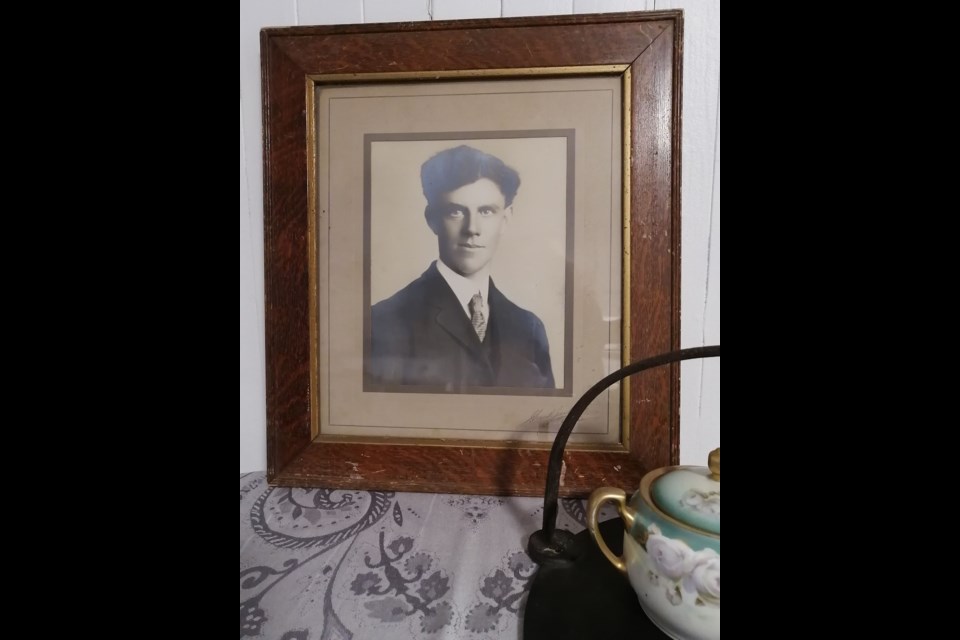Will the real Robert Graham please stand up? As I left the antique shop, I assured the staff that this mystery would be quickly solved. After all, the photograph is signed by a well-known Barrie photographer and the subject’s name is clearly written on the back.
A little over two years ago, I had the great pleasure of researching the original owner of a gorgeous collection of postcards. I wrote a story about the project and was very happy when a relative offered to take care of these treasures. In return, he sent a thank-you card and enclosed $20.
Since that time, I have been searching for a way to pay it forward and to use that money to send another family heirloom back to people who would get joy from it. Personally, I would be thrilled to get such an offer out of the blue.
The nicely matted, wood-framed portrait is quite large. In it, a young and confident man stares directly into the camera. A straight part slashes through his dark, curly hair. He wears a well-fitted three-piece suit with narrow lapels.
My initial guess, based on his presumed age, style of hair and clothing, and type of picture framing, is that Robert Graham is in his 20s and the portrait was done shortly after 1900. So, I’m looking for a gentleman of that name born in the 1880s. At least I think so.
What if he is 17 years old or 35 years old? Is he dressed in current fashion or a little behind the times? Did Robert live in Barrie or come into town one day from an outlying area to sit for a formal portrait?
I am starting to think that a name like Robert Graham is only slightly less common than John Smith. A number of Robert Grahams have been suggested to me, but which of them, if any, is the man in this portrait?
The time of the sitting can be narrowed down a bit by looking at the era during which John Francis Jackson, more commonly known as J. Frank Jackson, operated a photo studio in Barrie. Jackson came to Barrie in the late 1880s and worked as an assistant to photographer John Stephens before leaving to work on his own account in Kansas City.
In 1891, Jackson returned to Barrie, took over Mr. Stephens’ photography business and soon married Stephens’ only daughter. From then until 1921, J. Frank Jackson was considered one of Canada’s best in the photographic arts.
The mystery remains as to the identity of the young man with the steady gaze who sat for Mr. Jackson in his studio one day over 100 years ago.
Perhaps it was Robert Graham the prospector. In 1914, Robert and his brother, George, left their home town of Barrie and headed west. They were at Flin Flon, Man., when the zinc, copper, silver and gold that made that city was discovered. Robert remained there for the rest of his life.
It likely wasn’t Robert Graham, a farmer from Innisfil, as he was 38 years old by 1901. Perhaps it was Robert Graham, another farmer from Elmvale, who enlisted in the Canadian Expeditionary Force in 1918. His hair colour, listed on his attestation papers, was light brown. It definitely wasn’t Robert Henry Graham as his hair, described on that same form, was shown as “slightly bald.”
Then there was Robert Graham, who was once known as one of the top horse breeders and trainers in Canada. This man was instrumental in the success of the Dyment racehorses and show horses of the Brookdale Stables, where he was manager during the 1920s. Born in the late 1860s, this Robert Graham was probably too old to be our man.
Bob, as I have now started calling him, stares me down every time I pass his portrait that now rests on my dining table, propped up against the wall behind.
“Yes, Bob, I’m working on it.” I say when I walk by.
Each week, the Barrie Historical Archive provides BarrieToday readers with a glimpse of the city’s past. This unique column features photos and stories from years gone by and is sure to appeal to the historian in each of us.



